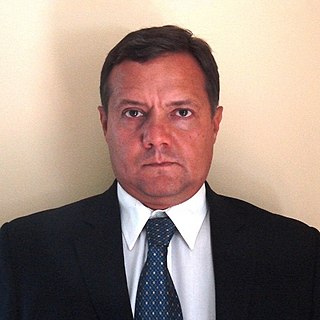In software development, agile practices include requirements, discovery and solutions improvement through the collaborative effort of self-organizing and cross-functional teams with their customer(s)/end user(s). Popularized in the 2001 Manifesto for Agile Software Development, these values and principles were derived from, and underpin, a broad range of software development frameworks, including Scrum and Kanban.
James O. Coplien, also known as Cope, is a writer, lecturer, and researcher in the field of computer science. He held the 2003–4 Vloeberghs Leerstoel at Vrije Universiteit Brussel and has been a visiting professor at University of Manchester.
Capability Maturity Model Integration (CMMI) is a process level improvement training and appraisal program. Administered by the CMMI Institute, a subsidiary of ISACA, it was developed at Carnegie Mellon University (CMU). It is required by many U.S. Government contracts, especially in software development. CMU claims CMMI can be used to guide process improvement across a project, division, or an entire organization. CMMI defines the following maturity levels for processes: Initial, Managed, Defined, Quantitatively Managed, and Optimizing. Version 2.0 was published in 2018. CMMI is registered in the U.S. Patent and Trademark Office by CMU.
In agile principles, timeboxing allocates a maximum unit of time to an activity, called a timebox, within which a planned activity takes place. It is used by agile principles-based project management approaches and for personal time management.

Ken Schwaber is a software developer, product manager and industry consultant. He worked with Jeff Sutherland to formulate the initial versions of the Scrum framework and to present Scrum as a formal process at OOPSLA'95. Schwaber and Sutherland are two of the 17 initial signatories of the Agile Manifesto. They are co-authors of the Scrum Guide. Schwaber runs Scrum.org, which provides Scrum resources, training, assessments, and certifications for Scrum Masters, Scrum Developers, Scrum Product Owners, and organizations using Scrum.

Scrum is an agile team collaboration framework commonly used in software development and other industries.
Strategic planning software is a category of software that covers a wide range of strategic topics, methodologies, modeling and reporting.

The business fable of The Chicken and the Pig is about commitment to a project or cause. When producing a dish made of eggs with ham or bacon, the pig provides the ham or bacon which requires his or her sacrifice and the chicken provides the eggs which are not difficult to produce. Thus the pig is really committed to that dish, while the chicken is only involved, yet both are needed to produce the dish.
The bus factor is a measurement of the risk resulting from information and capabilities not being shared among team members, derived from the phrase "in case they get hit by a bus". It is also known as the bus problem, truck factor, or bus/truck number.
Organizational patterns are inspired in large part by the principles of the software pattern community, that in turn takes it cues from Christopher Alexander's work on patterns of the built world. Organizational patterns also have roots in Kroeber's classic anthropological texts on the patterns that underlie culture and society. They in turn have provided inspiration for the Agile software development movement, and for the creation of parts of Scrum and of Extreme Programming in particular.

Ikujiro Nonaka is a Japanese organizational theorist and Professor Emeritus at the Graduate School of International Corporate Strategy of the Hitotsubashi University, best known for his study of knowledge management.
Linda Rising is an American author, lecturer, independent consultant. Rising is credited as having played a major role in having "moved the pattern approach from design into corporate change." She also contributed to the book 97 Things Every Software Architect Should Know, edited by Kevlin Henney and published by O´Reilly in 2009 (ISBN 059652269X).
Specification by example (SBE) is a collaborative approach to defining requirements and business-oriented functional tests for software products based on capturing and illustrating requirements using realistic examples instead of abstract statements. It is applied in the context of agile software development methods, in particular behavior-driven development. This approach is particularly successful for managing requirements and functional tests on large-scale projects of significant domain and organisational complexity.

A kanban board is one of the tools that can be used to implement kanban to manage work at a personal or organizational level.
Disciplined agile delivery (DAD) is the software development portion of the Disciplined Agile Toolkit. DAD enables teams to make simplified process decisions around incremental and iterative solution delivery. DAD builds on the many practices espoused by advocates of agile software development, including scrum, agile modeling, lean software development, and others.
eXtreme Manufacturing (XM) is an iterative and incremental framework for manufacturing improvement and new product development that was inspired by the software development methodology Scrum and the systematic waste-elimination (lean) production scheduling system Kanban(かんばん ).
The scaled agile framework (SAFe) is a set of organization and workflow patterns intended to guide enterprises in scaling lean and agile practices. Along with disciplined agile delivery (DAD) and S@S (Scrum@Scale), SAFe is one of a growing number of frameworks that seek to address the problems encountered when scaling beyond a single team.

Hirotaka Takeuchi is a professor of management practice in the Strategy Unit at Harvard Business School. He co-authored The New New Product Development Game which influenced the development of the Scrum framework.
Agile learning generally refers to the transfer of agile methods of project work, especially Scrum, to learning processes. Likewise, agile learning proceeds in incremental steps and through an Iterative design which alternates between phases of learning and doing. The tutors rather have the role of a learning attendant or supporter. In a narrower sense, it is intended to allow competence-oriented, media-based learning in the work process within companies. In addition, the term can take several other meanings and is also often used within e-learning and online environments.

Mike (Miguel) Beedle was an American theoretical physicist turned software engineer who was a co-author of the Agile Manifesto.







